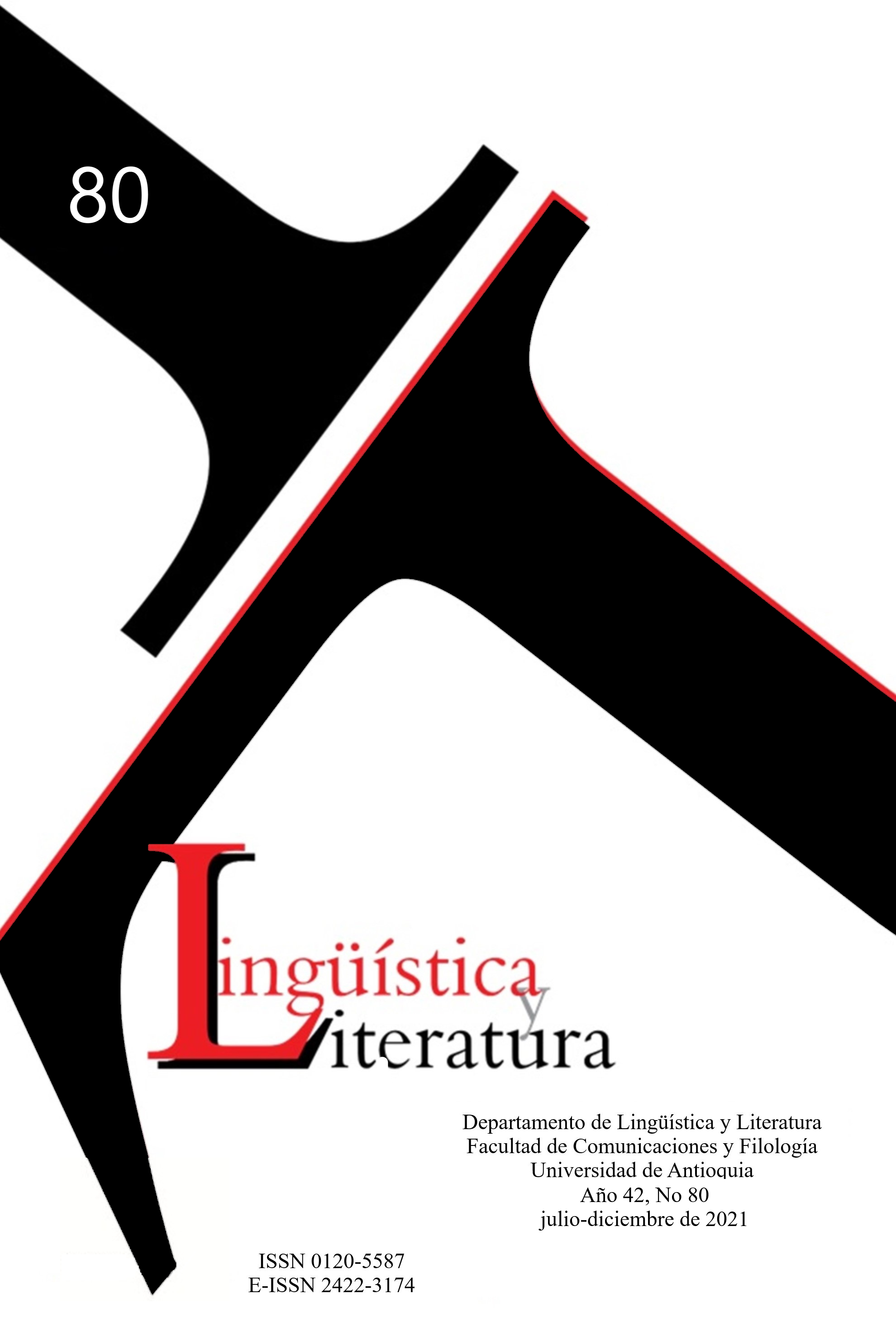Andrés Hurtado y la travesía del héroe fracasado en El árbol de la ciencia (1911) de Pío Baroja
DOI:
https://doi.org/10.17533/udea.lyl.n80a03Palabras clave:
El árbol de la ciencia (1911), travesía del héroe, Pío Baroja, héroe fallido, héroe fracasadoResumen
Este artículo presenta una lectura de la novela El árbol de la ciencia (1911) de Pío Baroja siguiendo la travesía del héroe. Primero, se evidencia la evolución de Hurtado como personaje heroico, luego se identifican los arquetipos de la obra y, finalmente, se presenta una lectura de la novela siguiendo las doce etapas de la travesía del héroe. Tal lectura es pertinente, pues los arquetipos y las etapas de la travesía son identificables. Además, a pesar de cumplir con las características del arquetipo de héroe, Hurtado se puede considerar un héroe fracasado, pues se suicida antes de finalizar su aventura.
Descargas
Citas
Agulló, E. O. (2015). Personaje y espacio urbano en la narrativa de Pío Baroja (Tesis Doctoral). Universidad de Córdoba. https://helvia.uco.es/xmlui/bitstream/handle/10396/13224/2016000001288.pdf?sequence=3
Baroja, P. (1924). Divagaciones de autocrítica: Conferencia leída en la Sorbona de París el 20 de marzo de 1924. Revista de Occidente, 10, 33-59.
Baroja, P. (1973). El árbol de la ciencia. Madrid: Caro Raggio.
Campbell, J. (1959). El héroe de las mil caras . México: Fondo de Cultura Económica.
Campbell, J. (1991). El poder del mito . Barcelona: Emecé Editores.
Camus, A. (2004). El extranjero. Barcelona: Emecé editores.
Costa, G. (2018). Alcolea del Campo x Madrid: Andrés Hurtado y el espacio social en la obra «El árbol de la ciencia» de Pío Baroja. Fólio - Revista de Letras, 10(1), Article 1, s.p. https://doi.org/10.22481/folio.v10i1.3813
Cueto Pérez, M. (2011). El discurso de los personajes en «El árbol de la ciencia». Archivum, 31-32, 233-240.
Eco, U. (1984). Apocalípticos e integrados . Barcelona: Editorial Lumen.
Eller, K. (1978). The Autobiographical Sources of Baroja’s «El Arbol de la Ciencia». Revista de Estudios Hispánicos, 12(3), 323-335.
Fuster García, F. (2012). Baroja como historiador: Literatura, microhistoria e historia desde abajo. La Torre del Virrey: Revista de Estudios Culturales, 11, 95-104.
Fuster García, F. (2014a). Baroja como materia de sus libros: Para una lectura de El árbol de la ciencia (1911) en clave autobiográfica. Revista de Literatura, 76, 171-197. https://doi.org/10.3989/revliteratura.2014.01.008
Fuster García, F. (2014b). Baroja y España: Un amor imposible: un ensayo sobre «El árbol de la ciencia» y la crisis de fin de siglo. Madrid: Fórcola Ediciones.
Glascock, J. D. (1966). The «Héroe Fracasado» in the Novels of Unamuno, Baroja and Azorin (Doctorate Thesis). Louisiana State University and Agricultural & Mechanical College. https://digitalcommons.lsu.edu/cgi/viewcontent.cgi?article=2150&context=gradschool_disstheses
González Martín, F. J. (2002). Tradición, revolución y religión en la España de Pio Baroja: (Una historia de la decadencia de España y sus mitos) (Tesis Doctoral). Universidad Complutense de Madrid. https://eprints.ucm.es/2344/1/AH0012701.pdf
Konkiewicz, M. (2016). La vida como drama, la muerte como salvación: El concepto del arquero orteguiano
en «El árbol de la ciencia» de Pío Baroja (Tesis Doctoral). Universidad de Valladolid. https://uvadoc.uva.es/handle/10324/16715
Llanos de los Reyes, M. (2002). Sobre los personajes y su técnica de caracterización en «El árbol de la ciencia». Espéculo: Revista de Estudios Literarios, 20, s.p. http://www.ucm.es/info/especulo/numero20/arbol_c.html
Mainer, J. C. (2012). Pío Baroja. Madrid: Taurus.
McArthur, R. G. (1998). Pío Baroja’s El árbol de la ciencia: Objectification as a Means of Survival. Revista Canadiense de Estudios Hispánicos, 22(3), 531-540.
Nietzsche, F. (1996). Así habló Zaratustra. Madrid: Alianza Editorial.
Ortega y Gasset, J. (1988). Pío Baroja: Anatomía de un alma dispersa. En Fox, E. & Ortega y Gasset, J. (Eds.), Meditaciones sobre la literatura y el arte (la manera española de ver las cosas) (pp. 117-194). Madrid:
Castalia.22. Pérez del Puerto, Á. (2015). La duplicidad de Lulú en El árbol de la ciencia. Romance Notes, 55(2), 191-201. https://doi.org/10.1353/rmc.2015.0040
Regalado, A. (2017). Pío Baroja: Cronología razonada (J. Lásaga, Ed.). Málaga: Servicio de Publicaciones y Divulgación Científica de la Universidad de Málaga.
Schopenhauer, A. (2016). El mundo como voluntad y representación: Vol. i. Madrid: Editorial Trotta.
Serna, J. (2012). El lector de novelas. La ficción de Andrés Hurtado. Pasajes: Revista de Pensamiento Contemporáneo, 37, 57-63.
Trueba Mira, V. (2003). Lulú: El extraño personaje de el árbol de la ciencia de pío Baroja. Anales de la Literatura Española Contemporánea, 28, 183-202.
Vargas Llosa, M. (2012). La civilización del espectáculo. Madrid: Alfaguara.
Vogler, C. (2002). El viaje del escritor. Barcelona: Editorial Ma Non Troppo.
Descargas
Publicado
Versiones
- 2021-11-13 (3)
- 2021-11-13 (2)
- 2021-07-30 (1)
Cómo citar
Número
Sección
Licencia
Derechos de autor 2021 Lingüística y Literatura

Esta obra está bajo una licencia internacional Creative Commons Atribución-NoComercial-CompartirIgual 4.0.
Creative Commons by-nc-sa
Aquellos autores/as que tengan publicaciones con esta revista, aceptan los términos siguientes:
1. La revista es el titular de los derechos de autor de los artículos, los cuales estarán simultáneamente sujetos a la Licencia Internacional Creative Commons Reconocimiento-NoComercial-CompartirIgual 4.0. que permite a terceros compartir la obra siempre que se indique su autor y su primera publicación en esta revista.
2. Los autores/as podrán adoptar otros acuerdos de licencia no exclusiva de distribución de la versión de la obra publicada (p. ej.: depositarla en un archivo telemático institucional o publicarla en un volumen monográfico) siempre que se indique la publicación inicial en esta revista.
3. Se permite y recomienda a los autores/as difundir su obra a través de Internet (p. ej.: en archivos telemáticos institucionales o en su página web) antes y durante el proceso de envío, lo cual puede producir intercambios interesantes y aumentar las citas de la obra publicada.










